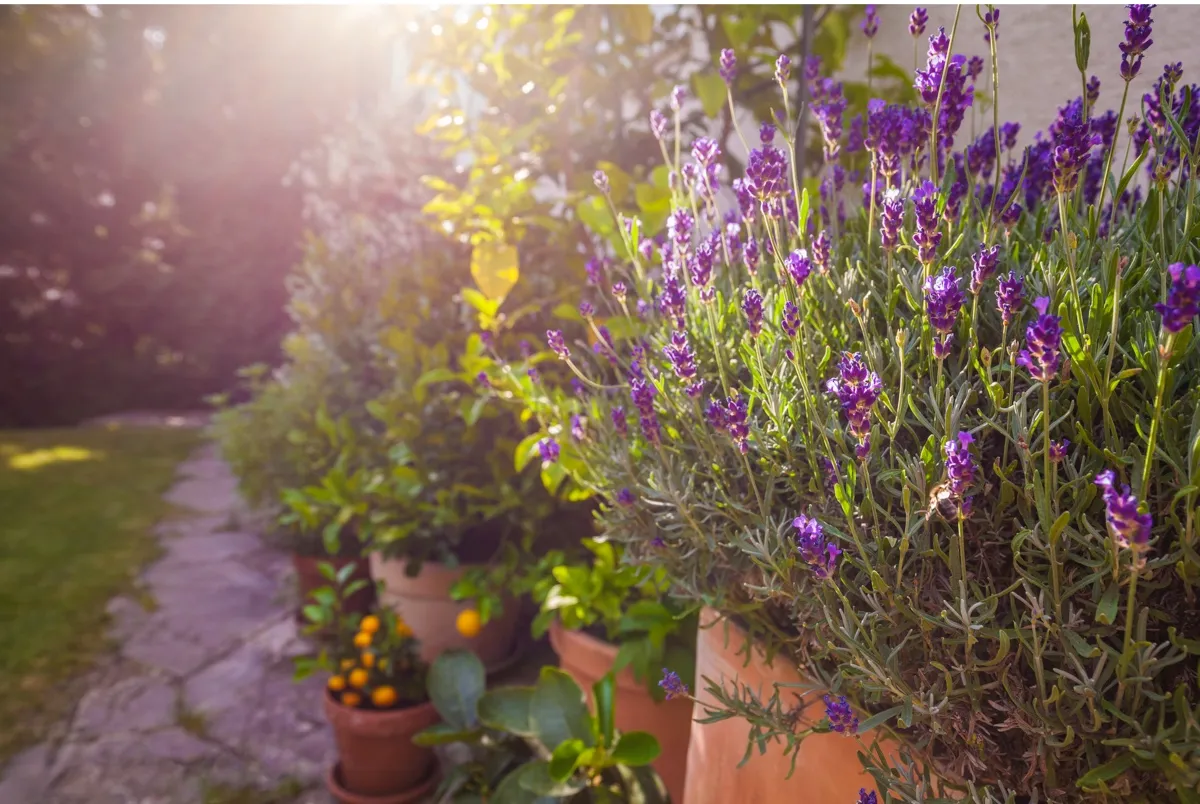If your garden is anything like ours, it’s probably looking a little sorry for itself, with flowers that are refusing to bloom, and sad, shrivelled grass. But take heart, if you plan your garden accordingly and plant a little smarter, then your green space will be better able to flourish in any future heatwaves.
“Moving forward into a warmer climate of the future will require gardeners up and down the UK to reconsider their choices and well-worn habits, particularly when thinking about the sorts of plants we grow in our gardens,” says Anthony Hall, from the head of collections at the arboretum in the Royal Botanic Gardens, Kew.
According to Hall, many of the plants that can survive hot weather are those which shed their leaves in summer rather than winter, helping to reduce the amount of water they lose in the scorching heat. Flowering spiny broom is one example of such a plant.
Plus, popular Mediterranean herbs like lavender and rosemary will not lose much water in summer, thanks to their narrow, needle-like leaves. They can also cope with hot sunshine and dry conditions.
Read more about hot weather:
- Reality check: Are the hottest cities in the world becoming inhabitable thanks to climate change?
- Are we too late to stop climate change?
- Are these searing temperatures the future of summers in the UK?
As well as Mediterranean plants, Hall says we should also look to plants grown from other warmer regions, like California, South Africa and Chile, as many of these will cope well with the warmer summer temperatures while staying hardy during our winters.
“Plant establishment is key. Most well-established Mediterranean plants will survive temperatures of over 30°C, but any prolonged period over 40°C is going to prove problematic for most plants.”
His advice for this is to plant up your garden during the autumn when the soil is still relatively warm. Make sure you water them well, and this way they’ll be well-established by the time summer rolls around.
Hall adds that gardeners should also seek out bulbs that remain dormant in high summer, before flowering in autumn, spring or early summer. In fact, certain bulbs need summer heat in order to flower well.

Faye Adams, the alpine and rock supervisor at Kew, agrees that plant choice is important, but there are other things to consider too. Figure out what parts of the garden are shady or in full sun, and establish what type of soil you have (chalky, clay, sandy, acidic or alkaline) to help you choose suitable plants for different zones of your garden. Picking the most suitable plants for your garden means they will generally be happier, healthier, and more resilient, needing less input in terms of watering and care.
“Thinking about hedging and planting trees is a good idea to create areas of shade. These are best planted as small trees in the autumn so they have a chance to get the roots established in the ground before the following summer, but they will need some additional water for the first few years to ensure good establishment,” she says.
Selecting the most suitable tree species is key for long-term sustainability, says Adams. A classic drought-tolerant tree is Callery pear (Pyrus calleryana ‘Chanticleer’), but there is increasingly more choice, such as crepe myrtle (Lagerstroemea indica) and the Judas tree (Cercis siliquastrum).
For those gardeners who are unhappy about the state of their lawn rather than their plants, take heart: it hasn’t died. During periods of hot weather it will stop growing and become dormant. It may even turn brown. But once we have some rain, it will soon start growing again. So step away from the lawnmower and wait for it to recover before starting to mow again in the autumn. Similarly, once the soil temperature drops below 5°C in the winter, the grass will become dormant again.
Read more about gardens:
- 18 of the best garden gadgets for 2022
- Gardening just twice a week improves wellbeing and relieves stress
- A scientist's guide to life: How to garden for wildlife
Once you’ve planted up your garden, it’s a good idea to add a layer of mulch to the soil surface. This can be done at any time through spring or autumn, or whenever you add some new plants to your garden.
‘Mulch’ is an additional layer of material – such as wood chippings, dead leaves, vermiculite, manure, gravel or grit – which can help the soil to retain moisture. As a bonus, mulching can also help suppress weeds, deter pests and provide a more attractive finish to your garden. You can even add a layer of mulch to pots, once they have been planted up.
“After a period of rain, a mulch can be applied to protect the soil surface from drying and help to hold in more moisture. As the mulch breaks down through the year, it helps to improve the structure of the soil and can increase the activity of beneficial insects,” says Adams.

Watering your garden is vital during hot, dry weather. Consider connecting a water butt to the guttering of your house or shed, to collect rainwater that you can use to water the garden. This will also help keep your water use a little lower.
You could even link up a series of water butts that overflow into each other in wet weather, to give you a vast supply of rainwater in drier conditions. Watering in the morning or evening is best, so there is less evaporation from the soil and plant surfaces.
Pots are particularly susceptible to moisture loss, so if warm weather is forecast, then move them into a shadier spot if possible.
“Avoid watering little and often, instead give the garden a good soak once a week in dry weather, especially in late spring early summer. This will encourage plants to send their roots deeper and make them more resilient in periods of drought,” says Adams. "Using grey water, like washing-up, bath and shower water, is perfectly fine for short periods, as the soil is a pretty good filter for soaps and debris.”
About our experts, Faye Adams and Anthony Hall
Faye Adams is the alpine and rock garden supervisor at the Royal Botanic Gardens, Kew.
Anthony Hall is the head of collections at the arboretum at the Royal Botanic Gardens, Kew.
Kew Gardens dates back to the 18th Century, but was officially founded and opened to the public in 1840. Its living collections include some 27,000 taxa, curated by Royal Botanic Gardens, Kew. It has been declared a UNESCO World Heritage Site. Along with its various houses and gardens, it has a herbarium and library, containing thousands of preserved plants and illustrations, respectively.

